At a time of public spending cuts, there is growing interest in policy to look at the scope of community-led initiatives to meet local needs. This has been demonstrated by the range of community ‘rights’ now in place across the UK, including new community empowerment legislation in Scotland.
What is the research about?
In response to this shift in policy, the Centre for Regional Economic and Social Research with the Joseph Rowntree Foundation have recently published their review of ‘the impact of community-led approaches to tackling poverty, focused at the neighbourhood level’. This is the first report to provide a substantial insight into the potential of community-led activities being used as poverty intervention measures more widely, specifically in low income communities.
How was the research carried out?
To look at the huge variety of community-led activities, a classification system was created and tested. From this, certain activities were selected, allowing academic and practical evidence to be gathered. It is important to note that the researchers found a lack of evidence which directly considers the impacts on poverty of these activities and so they largely theorised on the potential benefits.
The main findings are summarised below in themes, focusing on how each of the activities can address poverty and also highlighting the challenges and drivers of implementing these initiatives more widely.
Reference is also made to selected case study examples, including a SURF 2015 Award winner, the Helmsdale Affordable Housing Project. As well as providing evidence of this initiative, SURF continues to work with the JRF and Sheffield Hallam University to explore the current context for community led regeneration in Scotland and the UK.
Voluntary Action
Volunteering
This refers to volunteering which does not directly aim to strengthen community capacity and shape change locally. Nevertheless, this volunteering may indirectly bring about community regeneration.
How can Volunteering reduce poverty in communities?

Case Studies: Volunteering
Murton Mam’s, County Durham: A social group providing fun, supportive activities for single mothers, vulnerable to isolation and poor well-being.
Challenges & Drivers: Volunteering as a poverty intervention measure

Food Banks
The central aim of food banks is to reduce immediate hunger, with some organisations offering advice services for budgeting and general household management.
How can Food Banks reduce poverty in communities?

Case Studies: Food Banks
Cynon Taf Community Housing Group, Project 43: Building on the Food Bank model, an initiative where residents purchase food and make savings to repay housing debt.
Challenges & Drivers: Food Banks as a poverty intervention measure

Community Organising and Social Action
Both of these approaches are closely related but have distinct definitions in practice.
Community Organising refers to the building of community capacity and power to improve the quality of life locally, through the delivery of projects and services.
Social Action involves instigating action for social justice, with the aim of influencing policy and obtaining resources.
How can Community Organising and Social Action reduce poverty in communities?

Case Studies: Community Organising and Social Action
Thrive, Stockton-on-Tees : Community organisation which successfully campaigned against high cost credit.
Focus E15, London: Group of women proactively campaigning against reductions in social housing for private development in Newham.
Poverty Ends Now, Gateshead & Newcastle: Team of young people working to raise awareness of inequalities in education.
Challenges & Drivers: Community Organising and Social Action as poverty intervention measures

Community economic development: developing social assets
Neighbourhood enterprises
These are enterprises which work for sustainable regeneration, whether through economic, environmental, cultural or social activities, and focus on reinvesting their surpluses for the benefit of their geographical community.
How can Neighbourhood Enterprises reduce poverty in communities?
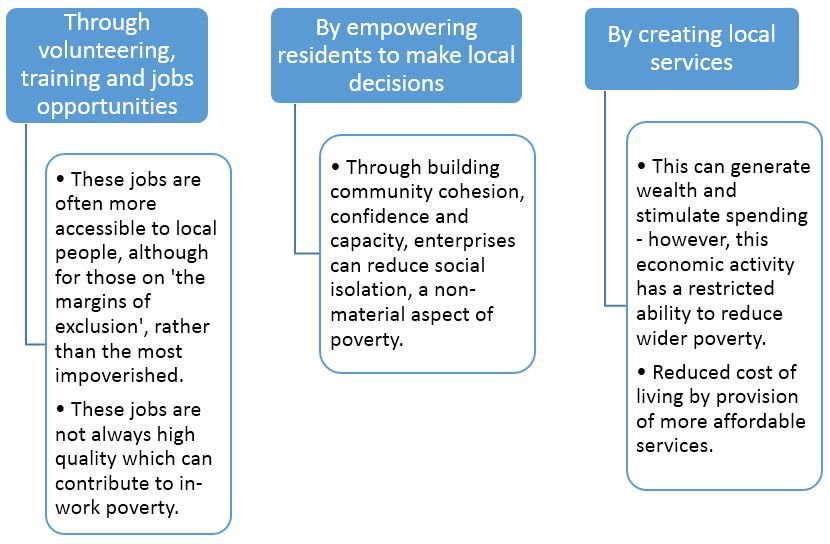
Case Studies: Neighbourhood Enterprises
Scallywags Parent Partnership Nursery, London: Affordable child-care with parent volunteering opportunities.
Heeley City Farm, Sheffield: Enterprise which generates wealth for local economy as well as providing training and employment.
Challenges & Drivers: Community Organising and Social Action as poverty intervention measures
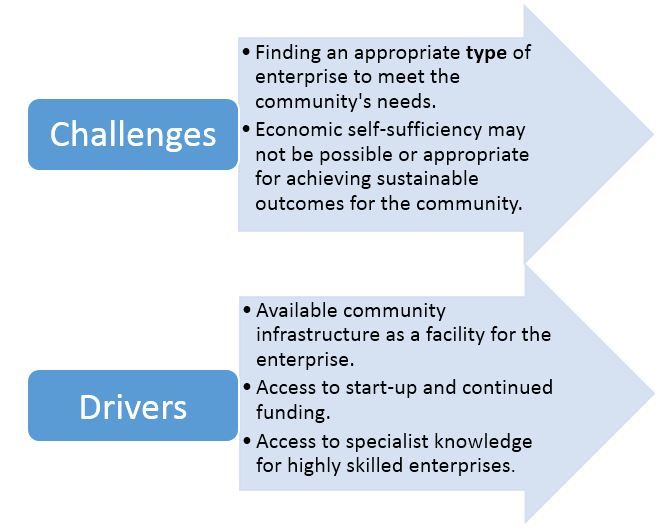
Credit Unions
These are not-for-profit financial co-operatives, run by staff and/or volunteers, which can offer a range of services including low cost credit, savings accounts and in some cases, debt and money advice.
How can Credit Unions reduce poverty in communities?
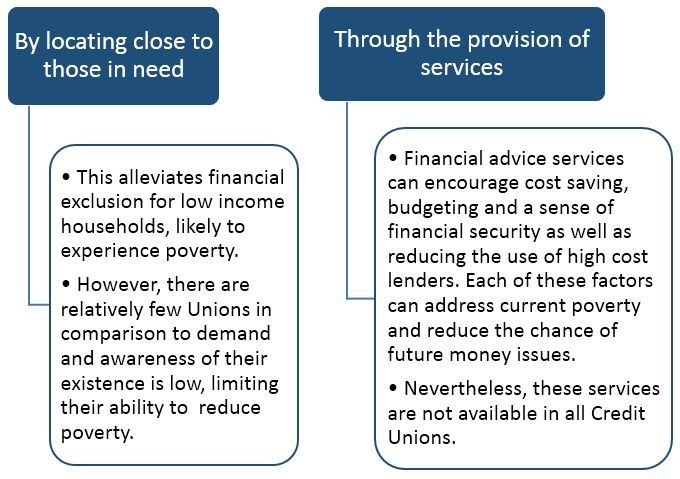
Challenges & Drivers: Credit Unions as a poverty intervention measure

Community Currencies
Community currencies work to facilitate informal mutual support by allowing members to trade goods and services between themselves without using cash.
Two types are included in the report:
- LETS (Local Exchange Trading Systems): Individuals can earn credits for providing a service (for example, childcare or food) which can then be ‘spent’ on the other services offered.
- Time banking: Volunteering hours are used as a currency. Unlike the LETS system where the value of a service is negotiated, each hour of volunteering is equal.
How can Communities Currencies reduce poverty in communities?
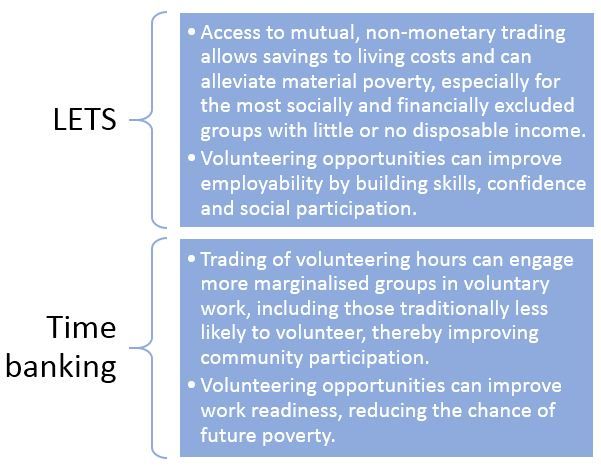
Case Studies: Community Currencies
King’s Lynn & West Norfolk LETS: An active Local Exchange Trade System.
Broadway Skills Exchange Time Bank: A time bank for homeless and vulnerably housed individuals.
Challenges & Drivers: Community Currencies as a poverty intervention measure
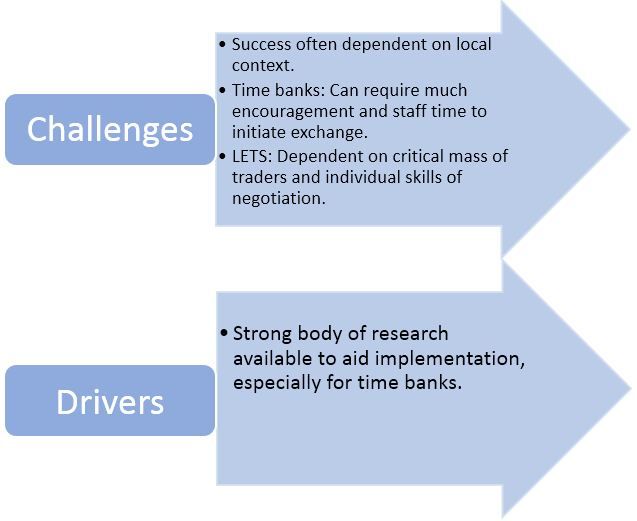
Community Assets
For communities, this means owning or managing assets including buildings and land, often to achieve long-term aspirations.
How can owning or managing Community Assets reduce poverty in communities?

Case Studies: Community Owned or Managed Assets
Gellideg Foundation Group, Merthyr Tydfil: Grassroots organisation which acquired vacant properties for offices, training workshops and a gym, with the aim of improving the quality of life for their children.
Challenges & Drivers: Community Owned or Managed Assets as a poverty intervention measure

Community Led Housing
This is involves communities addressing local housing need by instigating their own housing solutions, in a variety of ways, to create affordable, quality homes.
How can Community-Led Housing reduce poverty in communities?

Case Studies: Community Led Housing
Helmsdale and District Community Owned Housing, East Highlands: Working with the community, Housing Association and other key partners, the project addressed a range of poverty issues by building new energy efficient homes to rent in an area of population decline.
Challenges & Drivers: Community Led Housing as a poverty intervention measure

